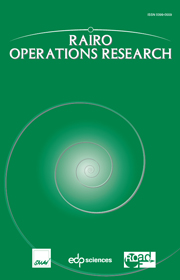Article contents
Fast computation of the leastcoreand prenucleolus of cooperative games
Published online by Cambridge University Press: 20 August 2008
Abstract
The computation of leastcore and prenucleolus is an efficient way ofallocating a common resource among n players. It has, however,the drawback being a linear programming problem with2n - 2 constraints. In this paper we showhow, in the case of convex production games, generate constraints by solving small sizelinear programming problems,with both continuous and integer variables. The approach is extended to games with symmetries (identical players), and to games with partially continuous coalitions. We also study thecomputation of prenucleolus, and display encouraging numerical results.
Keywords
- Type
- Research Article
- Information
- Copyright
- © EDP Sciences, ROADEF, SMAI, 2008
References
- 6
- Cited by


